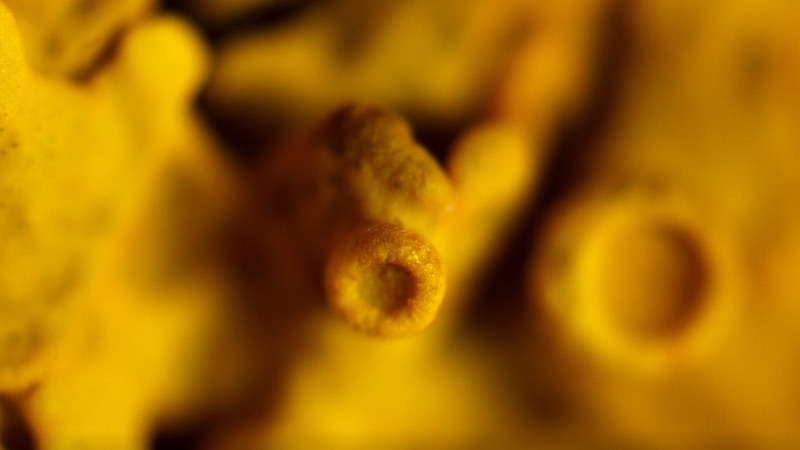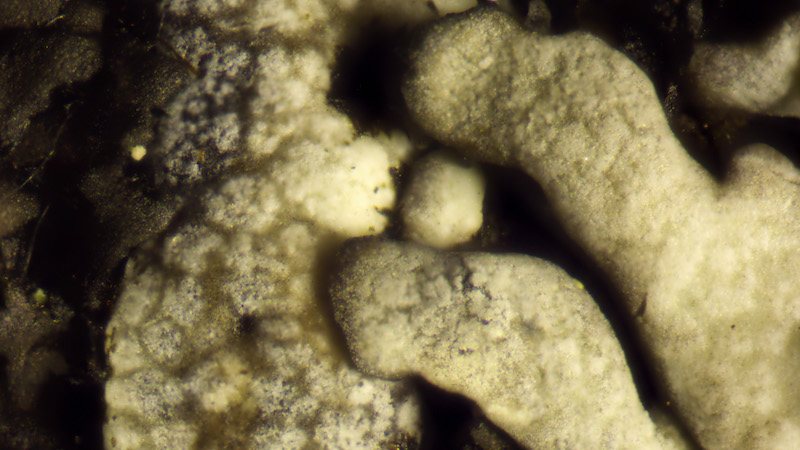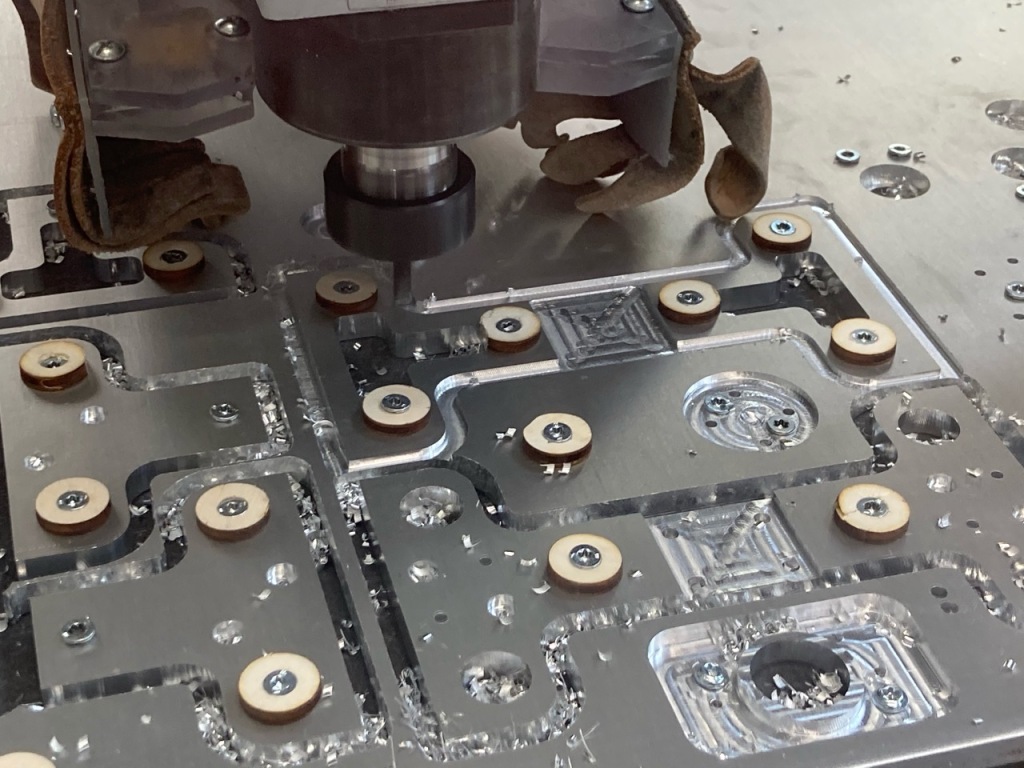I just finished my new film of microscope lichen landscapes, found on a rock in a fence at Trondenes in Harstad, Norway. The film was commissioned by The Arctic Moving Image & Film Festival with premiere october 13th, 2022.
The film was created using a custom made computer-controlled mechanical stage and a digital microscope. Almost 50000 microscope images were stacked and stitched together into miniature lichen landscapes, with a virtual camera flying over these landscapes.
For the soundtrack I used free-impro drumming (performed by Justin Bennett), inspired by the free-impro symbiosis of the lichen, that transforms into a sonic landscape of sci-fi space exploration and encounters with mysterious creatures.








My hope when making this film was to create a bit of awareness about what lichens are.
Apart from the extreme variations in appearance, textures and color, lichens have become the poster organisms for a new biology which challenges the idea of the individual and supplements the theory of evolution.
The title The intimacy of strangers is taken from a chapter about lichen in the excellent book on fungi by Merlin Sheldrake, Entangled life from 2020. It refers to the fact that lichen is not one organism, but a symbiosis of several organisms, and these organisms are not related at all, they are from different kingdoms. Mainly a fungi that partners up with a photosynthesising organism (either algae or bacteria). So instead of acquiring traits over long stretches of time through evolution (so called vertical gene transfer), the lichen combines traits from fungi and algae/bacteria through horisontal gene transfer: Once they have partnered up they have acquired these new traits, no need to wait millions of years.
This partnership also means it doesn´t make sense to talk about an individual, but rather an ecosystem of players with different roles.
Me and microscopes

Digital microscopes have been a part of my practice since 2007 when my live collaboration mikro with Justin Bennett was first performed at Paradiso in Amsterdam.
Like telescopes, microscopes extend our perceptive range, letting us see details of objects and organisms which because of scale remains hidden to us in everyday life. For me it is always a joy to explore the microscopic universes of textures, materiality and colors.
In 2016 I was commissioned to make a film for Vertical Cinema, a project initiated by Sonic Acts where cinemascope 35 mm film is shown in a vertical format. I decided to make a microscope film based on plastic wrappings from consumables.
I wanted to work with vertical motion for the vertical screen so I made a computer-controllable mechanical stage for the microscope to be able to create animation along one axis: For every image captured, the stage would move by a very small increment making it possible to then create an animation from the still images. This resulted in rift which premiered at the Sonic Acts festival in 2017, with soundtrack by Bennett.

While working on this project I imagined creating a mechanical stage that could move in both x (sideways),y (back and forwards) and z (up and down) directions, and also rotate around the axis of the microscope to be able to create curves that followed the terrain of the microscopic landscape.

In the late summer of 2020 I spent a lot of time alone working underground in a former water reservoir to make the two large scale installations Shadowgrounds for Factory Light Festival. One of my studio neighbours suggested that I should read Underland by Robert McFarlane. Which I did, or rather listened to while driving to or working in the water reservoir. One of the chapters in that book is about Merlin Sheldrake, which made me listen to his book as well about the mind-blowing world of the fungi.
I don´t quite remember how I in the same setting ended up listening to a book by Jon Larsen, of Hot Club de Norvège fame, about his obsessive search for micro meteorites. To document the micro meteorites that he eventually found many of, he collaborated with Jon Kihle who had a powerful microscope camera. This is when I first heard about the concept of focus stacking:
Microscopes have a very shallow depth of field, which means if looking at something which isn´t flat most of what you are looking at is out of focus. Focus stacking works around this by combining images taken with different focus distances, thus bringing out the three-dimensionality of whatever is under the microscope.

After having visited Harstad for location scouting this spring I decided that this was an opportunity to realise my next microscope project.
I had found the perfect location around Trondenes Kirke in Harstad, a beautiful area with a lot of history, both from the viking times and more recently the second world war (with Soviet labour camp and later a camp for the people of Northern Norway who were forced to leave their homes at the end of the war).
There are rock fences built around the church and the graveyard, covered with a carpet of lichen, the orange colours being the most noticeable. I thought it could be interesting to do a very site specific project, to just focus on life on this one rock in the fence (as a parallell to life on the bigger rock Earth).

I have always been interested in how things and organisms have completely different time cycles / durations, and seeing the lichen growing on the rocks on the fences around the church it made me think of everything that has passed by them during their existence (the oldest lichen that has been dated is 9000 years old and lives in Sweden). Although lichen and humans inhabit the same planet we live in parallell worlds with different time cycles.
Sometimes these worlds interact with each other: Lichen mine minerals from the rocks, thus releasing minerals trapped in the rocks to the greater eco system (that might end up in your body at some point). Lichens are often the first settlers on new territory: They make the first soil on new rock formations (islands, lava, mountains) which becomes a starting point for other life. Lichen notice the presence of the human world mainly through pollution which has caused several species to go extinct.

Many of my projects starts with first developing hardware and software that I then use to make a piece. This involves a lot of research and getting into things I know little about.
I often quote Ursula K Le Guin: “I don’t know how to build and power a refrigerator, or program a computer, but I don’t know how to make a fishhook or a pair of shoes, either. I could learn. We all can learn. That’s the neat thing about technologies. They’re what we can learn to do. ”






Making, learning and sharing tools is an important part of my practice, so the next section is an attempt at sharing some of the process (nerd alert) in making this film.
The challenge for the hardware side of this project was to be able to create a moving platform that was able to repeat the same motion over and over again with very small steps.
I am not so experienced with mechanical motion, so there was lot of trial and error before I was able to get the motion of the mechanical stage stable enough. I am lucky to have access to both the maker spaces bitraf and Fellesverkstedet in Oslo where I can make prototypes and finished work with laser cutters and cnc routers. In fact the mechanics and motion control of laser cutters and cnc machines are very similar to what my needs were for the microscope stage: Horizontal motion (x and y) and Vertical motion (to move the microscope closer or further away from the sample). On top of that I wanted to add mechanical rotation to this, thus having 4 axis of motion.
Luckily in the midst of my mechanical struggles I discovered the technique of stitching individual microscope images together to get a bigger mosaic image, something often used in medical and biological microscopy. This is to compensate for another inherent issue with microscope photography: The larger the magnification, the less you see of the sample (small field of view).
This changed my working process dramatically, as I instead of making individual paths for the mechanical stage to follow, I could do an automated grid scanning of a sample, and then make as many paths I would like in software later, making the whole process much more flexible.
So for each position in the grid there would be x number of images taken at different focus depths. As an example a grid of 5×5 would cover an area of about 8x8mm, and with maybe 50 images per tile this becomes 1250 images for one sample of lichen.
So how did this setup work?
The microscope camera is connected to a computer running a microscope imaging software (toupview in my case).
The mechanical stage consists of 3 motors being controlled via a standard arduino-based cnc 3 axis controller used in DIY 3D printers and CNC machines. The software to control this was Universal Gcode Sender, which basically sends information to the controller about the position for the XYZ axis among other things.
So for each XY position in a predefined grid (positions calculated in rhino/grasshopper but that´s another story) the Z axis will move closer or further away from the lichen sample to get different focus for the microscope. The actual low and high points is different for each sample so I do a manual check to get an idea of what works best for that particular lichen formation. For each Z position a trigger is sent from the controller via another microcontroller to trigger image capture on a computer. This is then repeated for every XY position in the grid setup.
After the individual images of each tile have been captured the process of stacking and stitching starts.
There are several options for focus stacking software. The two most popular ones are ZereneStacker and Heliconfocus.
For stitching there are some free alternatives like ImageJ/Fiji, with various plugins but I ended up using a commercial application, PTgui which is very intuitive to use and with great results.
After all the images have been stacked together, and when each tile has been stitched together with the other tiles I have a lichen landscape I can explore.
For this I create camera paths in free 3D software Blender from which I make animated sequences of the camera moving across the landscape. I started getting into Blender and camera paths when working with 3D scans in the performance Nye Krigere, and later in the series of point cloud works Vardø Kystopprøret, so I could use that experience to create camera (and light) paths to get interesting camera movements.
Finally for the soundtrack, I ended up using Reaper, which is a very reasonably priced DAW (digital audio workstation), and like Blender there is a big community of enthusiastic users sharing knowledge, making it easy to find what you look for.









